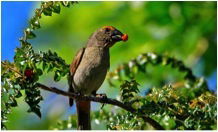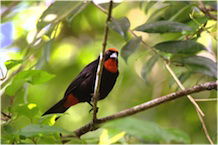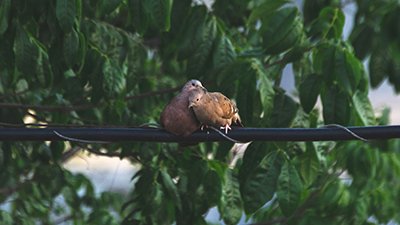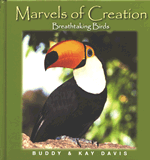Building a Beak
There’s more than one way to build a beak.
News Source
- ScienceDaily: “In Birds’ Development, Researchers Find Diversity by the Peck”
Darwin’s Galapagos finch beaks are commonly thought of as a prime proof of Darwinian evolution, although in reality they only demonstrate variety among finches. Proving that no new genetic information was required to achieve such diverse dietary adaptability, a 2010 study confirmed that Darwin’s finches developed 14 different sorts of beaks using the same developmental pathways and genetic products. Control of size and curvature during development produces the variations. Now a study of three species of Caribbean bullfinches has uncovered surprising diversity even in the ways beak diversity is achieved.
Caribbean bullfinches crush incredibly hard seeds “that no one else can touch,” says principal investigator Arhat Abzhanov. “You'd actually need a pair of pliers to crack these seeds yourself; it takes 300 to 400 Newtons [67 to 90 pounds] of force, so that's a really nice niche if you can do that. But the question is, what developmental changes must have occurred to produce a specialized beak like that?” While “all modern birds share the same overall beak skeletal structure,”1 the three-dimensional structure of bird beaks varies greatly. Beaks suited to a wide range of dietary options appear in nature, equipping birds to fill many ecological niches.

This male is a Lesser Antillean bullfinch (Loxigilla noctis), one of three species examined in this study of bird beak embryology. The embryos of this small bullfinch and Darwin’s finches (Geospiza) build their beaks using “similar cell populations and genes to establish very distinct beak shapes.”2 Thus the “same” genes direct the use of a cartilage template to achieve different results. This image by Dick Daniels (carolinabirds.org through en.wikipedia.org).

This female is a Greater Antillean bullfinch (Loxigilla violacea). L. violacea, the Puerto Rican bullfinch (Loxigilla portoricensis), and the smaller Lesser Antillean bullfinch (Loxigilla noctis) all have deep wide beaks able to crush very hard seeds. Their beaks are the same shape with slightly different sizes. However, the [two] larger species “use a novel combination of two signaling molecules to build a beak identical in shape to the [beak of the] smaller bullfinch”3 without producing a cartilage template. Thus, genetically and developmentally different processes produce the same beak shape in different Loxigilla species (photo by José M. Pantaleón at www.seas.harvard.edu).

This male is a Puerto Rican bullfinch (Loxigilla portoricensis). The same developmental process builds its beak and that of the Greater Antillean bullfinch (L. violacea) directly from bone. Yet Loxigilla noctis builds a beak of identical shape using a different sequence of regulatory genes and a cartilage template. Image from Carlos David Hernández through en.wikipedia.org.
“Variation in beak shape has profound impacts on the ability of an organism to survive and reproduce in the wild,” Abzhanov and colleagues write. “Therefore, its adaptive significance coupled to the extreme levels of diversity observed in nature make this trait ideal for tackling developmental and evolutionary questions about morphological diversification in general.”4
Variation in beak shape has profound impacts on the ability of an organism to survive and reproduce in the wild.
“Most people assume that there's this flow of information from genes for development to an inevitable morphology,” Abzhanov says. “Those beaks are very highly adaptive in their shapes and sizes, and extremely important for these birds. In Darwin's finches, even one millimeter of difference in proportion or size can mean life or death during difficult times. But can we look at it from a bioengineering perspective and say that in order to generate the exact same morphological shape, you actually require the same developmental process to build it? Our latest research suggests not.”
Abzhanov found that the same developmental path applying the same genetic information can produce different sorts of beaks. But he also found that the same beak shape can be achieved using different developmental pathways and different genetic instructions. Thus, the researchers report, “Different developmental programs can generate identical shapes, and similar developmental programs can pattern different shapes.”5
By geometrically analyzing the beaks of the three living Loxigilla bullfinch species, the researchers were able to confirm their beaks of varying size were identical in shape. To study beak embryology, they went to the Dominican Republic, Barbados, and Puerto Rico to collect tiny, fragile, freshly laid eggs from dome-shaped nests often found atop tall cacti. Beaks begin to develop around day 6 or 7.
The small bullfinch’s (Loxigilla noctis) embryo starts with a cartilage template and, under the influence of the same sequence of control genes seen in Darwin’s finches, builds a bony beak. Its beak does not resemble any of the 14 Darwinian finch beaks. But the two larger Loxigilla species form bony beaks without a cartilage template under the direction of a different combination of genes.
“Despite the fact that these birds are using different systems, they end up with the same shape beak, and a different shape beak from Darwin's finches,” Abzhanov emphasizes, even though the system operating in L. noctis is the same system as that in Darwin’s finches. “So that reveals a surprising amount of flexibility in both the shapes and the molecular interactions that support them. . . . For evolution, the main thing that matters for selection is what the beak actually looks like at the end, or specifically what it can do. The multiple ways to build that beak can be continually changing, provided they deliver the same results.”
This study has not provided an example of Darwinian evolution. It has not revealed acquisition of a blueprint for evolutionary progress toward a non-bird. On the contrary, it hints at the multiplicity of ways that existing genetic information can be used to achieve diverse results. God created “every winged bird according to its kind” in order to “let birds multiply on the earth” (Genesis 1:21–22). This study suggests one of the ways God equipped them to vary within their kinds in order to adapt to changing variable ecological conditions in the world.
Further Reading
For More Information: Get Answers
Remember, if you see a news story that might merit some attention, let us know about it! (Note: if the story originates from the Associated Press, FOX News, MSNBC, the New York Times, or another major national media outlet, we will most likely have already heard about it.) And thanks to all of our readers who have submitted great news tips to us. If you didn’t catch all the latest News to Know, why not take a look to see what you’ve missed?
(Please note that links will take you directly to the source. Answers in Genesis is not responsible for content on the websites to which we refer. For more information, please see our Privacy Policy.)
Footnotes
- R. Mallarino et al., “Two Developmental Modules Establish 3D Beak-shape Variation in Darwin’s Finches,” PNAS 108, no. 10: 4057–4062, doi: 10.1073/pnas.1011480108.
- C. Perry, “In Birds’ Development, Researchers Find Diversity by the Peck,” John A. Paulson School of Engineering and Applied Sciences, Harvard, September 24, 2012, http://www.seas.harvard.edu/news/2012/09/birds-development-researchers-find-diversity-peck.
- Ibid.
- Ibid.
- R. Mallarino, “Closely Related Bird Species Demonstrate Flexibility Between Beak Morphology and Underlying Developmental Programs,” PNAS 109, no. 40 (October 2, 2012): 16222–16227, doi: 10.1073/pnas.1206205109.
Recommended Resources

Answers in Genesis is an apologetics ministry, dedicated to helping Christians defend their faith and proclaim the good news of Jesus Christ.
- Customer Service 800.778.3390
- © 2024 Answers in Genesis





